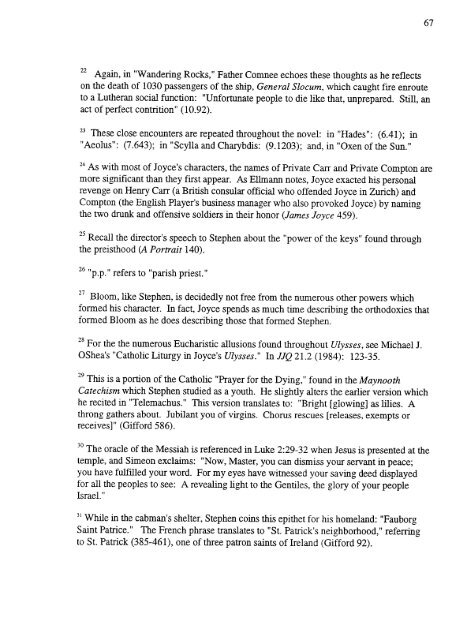Faubourg Saint Patrice - ScholarsArchive at Oregon State University
Faubourg Saint Patrice - ScholarsArchive at Oregon State University
Faubourg Saint Patrice - ScholarsArchive at Oregon State University
Create successful ePaper yourself
Turn your PDF publications into a flip-book with our unique Google optimized e-Paper software.
22<br />
Again, in "Wandering Rocks," F<strong>at</strong>her Comnee echoes these thoughts as he reflects<br />
on the de<strong>at</strong>h of 1030 passengers of the ship, General Slocum, which caught fire enroute<br />
to a Lutheran social function: "Unfortun<strong>at</strong>e people to die like th<strong>at</strong>, unprepared. Still, an<br />
act of perfect contrition" (10.92).<br />
23<br />
These close encounters are repe<strong>at</strong>ed throughout the novel: in "Hades": (6.41); in<br />
"Aeolus": (7.643); in "Scylla and Charybdis: (9.1203); and, in "Oxen of the Sun."<br />
24 As with most of Joyce's characters, the names of Priv<strong>at</strong>e Carr and Priv<strong>at</strong>e Compton are<br />
more significant than they first appear. As El imam notes, Joyce exacted his personal<br />
revenge on Henry Can (a British consular official who offended Joyce in Zurich) and<br />
Compton (the English Player's business manager who also provoked Joyce) by naming<br />
the two drunk and offensive soldiers in their honor (James Joyce 459).<br />
25<br />
Recall the director's speech to Stephen about the "power of the keys" found through<br />
the preisthood (A Portrait 140).<br />
26<br />
27<br />
refers to "parish priest."<br />
Bloom, like Stephen, is decidedly not free from the numerous other powers which<br />
formed his character. In fact, Joyce spends as much time describing the orthodoxies th<strong>at</strong><br />
formed Bloom as he does describing those th<strong>at</strong> formed Stephen.<br />
28 For the the numerous Eucharistic allusions found throughout Ulysses, see Michael J.<br />
OShea's "C<strong>at</strong>holic Liturgy in Joyce's Ulysses." In JJQ 21.2 (1984): 123-35.<br />
29 This is a portion of the C<strong>at</strong>holic "Prayer for the Dying," found in the Maynooth<br />
C<strong>at</strong>echism which Stephen studied as a youth. He slightly alters the earlier version which<br />
he recited in "Telemachus." This version transl<strong>at</strong>es to: "Bright [glowing] as lilies. A<br />
throng g<strong>at</strong>hers about. Jubilant you of virgins. Chorus rescues [releases, exempts or<br />
receives]" (Gifford 586).<br />
30<br />
The oracle of the Messiah is referenced in Luke 2:29-32 when Jesus is presented <strong>at</strong> the<br />
temple, and Simeon exclaims: "Now, Master, you can dismiss your servant in peace;<br />
you have fulfilled your word. For my eyes have witnessed your saving deed displayed<br />
for all the peoples to see: A revealing light to the Gentiles, the glory ofyour people<br />
Israel."<br />
'While in the cabman's shelter, Stephen coins this epithet for his homeland: "Fauborg<br />
<strong>Saint</strong> <strong>P<strong>at</strong>rice</strong>." The French phrase transl<strong>at</strong>es to "St. P<strong>at</strong>rick's neighborhood," referring<br />
to St. P<strong>at</strong>rick (385-461), one of three p<strong>at</strong>ron saints of Ireland (Gifford 92).<br />
67















